One of the main reasons that I created this web site was that I wanted to share my knowledge and experience with everyone that loves quilting. Whether you are new to quilting or "an old hand" there is always something new to learn. This section of the website is the place to go where I share some of the fundamentals of good quilting practice and also where you can find out what quilting services are available to help you complete your latest quilting project. |
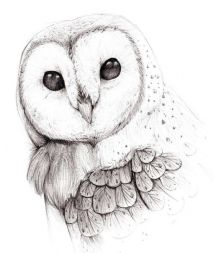 |
| Barn Owl |
Quilt Services
Click on the items below to go directly to the section that interests you
Preparing your Project for Quilting
Machine Quilting Service Pricing
Booking your Project in for Quilting
Preparing your Project for Quilting
I can help you finish your quilts by machine quilting the top (in either a custom style or an edge to edge design) and then, if you want, bind your quilt so it is ready to use. I can provide the backing fabric for your quilt project (have a look at the range of backing fabrics on offer by clicking on this link). I can also supply the batting for your quilt project (have a look at the range of batting on offer by clinks on this link).
You can of course supply your quilt top with your own batting and backing fabric. Either way I am happy to provide a quilting service to suit your requirements. All quilts will be individually quoted once sighted (I cannot provide a price without seeing the quilt).
With or without supplying your own batting or backing fabrics there are some basic quilt preparation tasks that you should follow to ensure your quilt can be successfully quilted. These tasks not only make life easier for the operator of the machine, but can often save you money too (as you will be charged extra for "preparation time" if needed prior to the quilt being loaded onto the machine).
1. Ensure that your backing is big enough - I recommend that your backing is at least 8cm (or 3 inches) bigger around all the sides of the quilt top. Note: This means 3" on top, 3" on bottom, 3" on each side. This is needed for pinning to the canvases at the top and bottom & to allow room for the clamps on the sides that hold the backing in place under the quilt top and batting and to ensure that there will be enough backing when the quilting gets to the end.
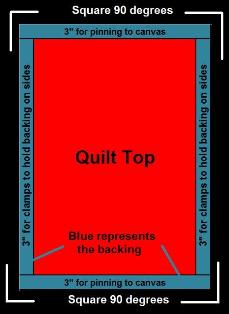
If the backing fabric is the same size as the quilt top then you should add a piece of similar or complimentary fabric horizontally and vertically offset through the middle of the piece of backing material rather than adding the extra fabric around the outside edge of the backing to increase its size. The reason being that the quilt top creeps down and across to the right during the quilting process and you end up with the extra strip being on the edge of the quilt where it is more noticeable and can cause the bindings to appear more bulky.
Similarly it is not possible to centre a quilt top onto a piece of backing fabric as the quilt top creeps down and to the side during the quilting process.
If you do not have enough backing fabric I will phone you to discuss what other options you may have.
2. Make sure that your backing is square and sits flat - no puckers if you have joined pieces; the sides are straight and the selvedge’s have been cut off.
Basically try and put as much care into the backing as the top - you will be disappointed if the top looks great but the backing lets the quilt down.
3. Ensure that your batting (wadding) is large enough as above it should be 8cm (or 3 inches) bigger around all the sides of the quilt top. Also if you have to join the batting make sure it doesn't leave a seam which will be felt through the quilting - just butt the edges together and either hand or machine the pieces together. If in doubt, consult with your quilter about the best option for your quilt.
4. Longarm quilters are busy people - and time is money so there a number of tips you can do you minimise your cost and maximise your end result:
a) Trim or remove any loose threads so that they do not get sewn into the quilt
b) DO NOT supply your quilt top already basted to the backing and batting as I cannot put your quilt onto the longarm machine like this, I will have to un-pick it and that will be an extra charge
c) Beware of sewing any raised embellishments onto your quilt top such as buttons, beads, sequins etc. This will incur a time and $ cost impact as it is harder to sew around them and they do run the risk of being damaged by the machine, as well as limiting the type of quilting patterns that can be used.
d) Ensure that your quilt top (and backing fabric if supplied) is ironed before you send it to me. Make sure the seams are ironed flat and the way they are supposed to go. Then fold it gently before packing it to send to me. If the quilt comes to me badly creased this will impact the final quality of the quilt so I would have to iron it before quilting (this would be an extra charge).
e) Make sure all borders are correctly attached (aligned and of correct length). Poorly attached borders will create a “wavy” border making it difficult to keep the quilt square and prevent tucks from occurring.
5. Before you supply your quilt top to me for quilting there are a few things you need to consider:
a) What sort of quilting designs do you want on your quilt top?
b) Does the quilt have a top (which way is up)? Please mark the top of your quilt if it is not obvious. Use a safety pin or a bit of fabric loosely stitched on or near the top.
c) What is the purpose of the quilt (eg wall hanging, bed quilt, cot quilt, competition quilt etc)?
d) What sort of things do you (or the recipient if it is a present) like (hearts, flowers, straight lines, busy things, etc)
e) What colour threads do you like? Do you like the look of blending threads or contrasting threads?
f) What sort of money do you want to spend - generally speaking the more "thinking" the quilter has to do and the more intricate the overall design, the more the quilting will cost.
Remember, if you say "Quilt what you think is best" then you will get what the quilter interprets your quilt top needs. I will guide you with some ideas and suggestions of what can be achieved but it helps if you have thought of what sort of effect you are looking for when I ring you to discuss your quilt and give you the quote.
For a more detailed discussion on this subject refer to my info sheet "Choosing the best Quilting Design for your Quilt".
6. Ensure your quilt is adequately packed for shipping. I recommend that you place your quilt in a plastic bag (in case the packaging gets wet) and then in a shipping box to protect your quilt. If your quilt is just sent in a plastic courier satchel it may get ripped in transit and damage your quilt.
Please ensure that you have included a completed booking sheet with your quilt (click on this link to print out a booking sheet). That way I can contact you to discuss and quote your job and to deliver your quilt back to the correct address.
These are a few suggestions for preparing your quilt top. If you have any questions you are welcome to contact me.
You can download and save or print the above article by clicking on this pdf icon
Machine Quilting Service Pricing
I have a pricing structure based on the complexity of the quilting which is requested and the size of the quilt top itself. The prices below are in New Zealand Dollars.
Calculating the size of the quilt top
I calculate the size of the quilt top by measuring the length and width of the quilt in meters and multiplying it to get a figure based on its square metre.
For example: The length of the top is 1.8m and the width is 1.2m.
multiply 1.8 x 1.2 and you get a figure of 2.16 sq m.
Once the size of the quilt top is calculated then the cost of the quilting is going to be dependant on how complex you want the quilting design to be, based on the prices below:
|
Edge to Edge quilting (pantograph designs) |
$40 per square metre |
|
Border with Edge to Edge Centre |
$45 per square metre |
|
Basting eg joining quilt top, batting and backing together |
$18 per square metre |
|
Binding & turning (machine sewn, customer to provide binding material) |
$10 per linear metre |
|
Minimum charge (small quilts, wall hangings, table runners etc) |
$40 per item |
|
Emergency Turn-around fee to jump ahead of other quilts that are already booked in |
$50 per quilt |
|
Backing Fabric: see my range available in the backing fabric section of this website |
From $15 per metre |
|
Batting: see my range available in the batting section of this website |
From $20 per metre |
|
Thread cost is included in the quilting cost. Optional Specialty threads can be supplied - just ask |
Costed per quilt if requested |
|
Return Shipping (sealed in plastic, inside a box or in a satchel and couriered with signature required for delivery confirmation) |
Cost will be advised |
This all looks very complicated but it really isn't. However, I am happy to talk about it over the phone or by email if you would prefer. Because in the end every quilt is unique and special, so every quilt is individually quoted to you and approved before I proceed with the work.
PLEASE NOTE - that due to a change in personal circumstances I am no longer able to accept Custom Quilting or Heirloom Quilting work.
I will accept cash, credit card and Direct Debit (or Internet payment) within New Zealand.
NB: These prices are as at May 2022 and are subject to change.
Booking your Project in for Quilting
To make it easier for you to book your quilt project with me for quilting you will need to complete the attached Booking Sheet (attached pdf file).
This ensures that when you send your quilting project to me I have all the important information required for me to correctly quote your job and to be able to communicate with you and most importantly return your project to you on its completion.
Click on this Customer Booking Sheet pdf file to print it out, complete it and enclose with your quilt project.
Choosing the Best Batting For Your Quilt
Picking a good batting is more important that you think. Nothing does more to determine the comfort and cuddliness of your quilt than the batting you use in it.
When you're just starting out in quilting, it can be very hard on your budget to have invested in all the tools and supplies you need, fabric for your first quilt, and then spend even more money for your batting.Because of this, many quilters will choose to skimp on batting. But this is not always the best thing to do!
Hopefully the information tips below will help you make sense of all this so that you can make an informed decision about getting the right batting for your project.
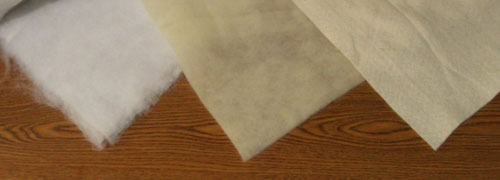
Is there good or bad batting?
There's no real "good" or "bad" batting. You just have to try it out for yourself. You need to decide what you like and what you dislike. Choice of batting can be entirely subjective.
How much will I need to spend?
This really depends on how big a quilt you're making! The price for high quality polyester batting will range from $20/m and up, but this price will change depending on how thick the batting is that you choose.
There is such a thing as too cheap batting. Beware of some 100% polyester battings sold at some furnishing / home décor shops. These battings are made very cheaply and will beard almost instantly inside your quilt. Or they could be of too high a loft so are not suitable for quilts. Unless you want a ruined project, don't make the price tag your #1 reason for buying it.
What is bearding?
You know the fuzz your husband gets on his chin after a day or two of not shaving? Bad battings will create the same effect on both sides of your quilt. Bearding means that the fibers in the batting have pulled apart and are migrating through the fabric weave of your quilt.
What you will see at first is little wisps of batting poking through the material. After you wash the quilt you may notice that the surface has started to get lint balls all over it like a fuzzy sweater.
Once this happens, there's not much you can do other than rip out all your quilting stitches, scrap the batting and quilt the whole thing over again. This is a good reason to go with a trusted brand of quilters batting, or at least the advice of an experienced quilter.
What is drape?
Go into your bedroom and look at your bedspread. When you pick it up and lay it over your arm does it drape over you in a nice, soft, comforting way? Or does it sit stiffly against your skin like stale bread?
This is what drape means, the way your quilt will feel after you've quilted it. Your batting choice, combined with how much quilting you do, will largely determine how your quilt drapes when it's done. Higher quality battings are able to take more quilting stitches and still retain their soft, cozy feel, whereas cheaper battings will just turn into cardboard.

What is loft?
Loft is another word for thickness. Older sources of batting from 20+ years ago were very thick but modern batting is often of a smaller loft.
While loft might have lost some of its loft (thickness), it still basically means the same thing: the higher the loft, the thicker your quilt. The thicker your quilt is, the warmer it will be.
You don’t have to have the thickest batting to get the warmest quilt. New wool battings have come out that are very thin, but are still super warm.
Bear in mind that the thicker your batting, the more trouble it will be to baste or to quilt on a Long Arm Quilting machine leading to inconsistent results on some combinations of quilt fabric, batting and backings.
What is the difference between Cotton and Polyester Battings?
Cotton battings are made from grown plant fiber that has been needle punched into place. Most cotton battings will shrink when they are washed, and some will not. Cotton battings usually have a lower loft.
Polyester battings are made from synthetic fibers that are also needle punched into place. They typically don't shrink and can have a really beautiful drape in the finished quilt. The new polyester battings breathe easily and make very comfortable quilts.
How your Batting Determines Your Quilting
It's also important to note that most battings specify an amount of space you can leave un-quilted (between stitches).
Some battings may indicate that they are strong enough to stitch up to 8" apart without worrying about the batting shifting or bunching after you wash it. However I recommend that you have no more than 4 - 5" spacing on your quilt between stitches to give it a more even effect overall.
Final tips for picking the perfect batting - Ask yourself the following:
1. What will this quilt be primarily used for? Wall hangings can use any batting, but thicker usually means it will hang better. Bedspreads can also use any batting, but keep in mind the season.
2. Are you planning to use any special techniques? Do not use cotton battings with any white work, or trapunto quilt! The seed pods will show through white fabric.
3. How much quilting do you want to do? Polyester battings allow you to go 8" or more between quilting stitches. The more quilting you do, the stiffer your quilt will be. Some battings are better at staying flexible even with a million stitches!
4. What's your budget? Plan to put $20 - $40/m into your quilting batting. Buying a bigger piece of batting than you need is a good idea so you can use the leftover pieces for small quilts or wall hangings.
You can download and save or print the above article by clicking on this pdf icon
Choosing the Best Quilting Design for your Quilt
As much as we’d like to think each quilt we make is a masterpiece destined for greatness, sometimes we must let go of our delusions of grandeur and move on. Some quilts clearly shout, “PLEASE custom quilt me!,” and some yell, “No way! Overall design, please!”
Types of Quilting Styles
All over, or edge-to-edge quilting (also known as a pantograph design), means that the quilting pattern starts at one side of the top and goes to the other side regardless of blocks or borders. Edge-to-edge quilting is at the cheaper end of the cost spectrum when it comes to quilting.
Custom quilting is where each block and border is treated separately and a combination of quilted designs will be sewn onto the quilt to enhance the different elements or areas of the quilt. Styles such as stitch-in-the-ditch, cross hatching, stipple effect or other custom patterns can be used. Because of the additional design work and attention detail required along with more denser stitching, custom quilting is more expensive.
Heirloom quilting is the highest quality quilting. It can be highly decorative with a great deal of movement. It will be dense, adding its own statement to the quilt but not overriding the piecing composition. Heirloom quilting, being on the highest end of the cost spectrum, is for the pieced top that will be entered into competitions and/or used as a focal piece in the decoration of your home. Depending on the desire, the pieced top can be quilted with remarkable results using such patterns as feathering, McTavishing, echoing and skilfully executed cross-hatching and stitching in the ditch along with other themed patterns.
The “feel” of your Quilt
The type of quilting chosen can also have an impact on the “feel” of a quilt. An edge-to-edge quilting pattern is generally of a lower density of stitching. This helps to keep the quilt more “fluffy or cuddly” as the loft of the batting will not be as compressed. High density custom or heirloom quilting will have much more stitching compressing the batting loft and making the quilt much stiffer (great for wall hangings or display – not so nice for a comfortable quilt!
Simple questions to ask yourself before deciding on a quilting pattern
Many of the quilts we make would look good in either quilting style. The trick is deciding which way to go. When debating between custom and edge-to-edge quilting for your quilt, you’ll save yourself lots of time and stress if you answer these questions to help you decide before you bring you quilt in:
1. What is your budget?
As we have seen above the type of quilting chosen varies in cost. If you are on a tight budget or the quilt does not warrant the expenditure then choose edge-to-edge. If budget is not an issue then custom may be an option open to you.
2. When is the quilt needed?
Edge-to-edge quilting is the quicker of the styles of quilting, with custom and heirloom quilting taking much longer to complete. Remember that your quilt will not be the only quilt being undertaken by your chosen long-arm quilter. A long-arm quilter can complete many more edge-to-edge quilts in the time it takes to do a custom job. So the wait time of edge-to-edge quilts is usually shorter. Be prepared to have a estimated completion time for custom or heirloom quilts of several months away. Whereas an edge-to-edge quilt can often be competed in a matter of weeks. So make sure that you allow plenty of time to complete this work before trying to meet your own deadlines!
3. Who will be the recipient of your quilt?
Is it for your parents’ 25th anniversary? It deserves custom work.
Is it for your six-year-old niece? She’ll jump on the bed with it - edge-to-edge would be best.
Is it for your son, a university student? Definitely edge-to-edge - he’ll never wash it!
Is it for your best friend who’s recovering from breast cancer? Could go either way.
4. How will your quilt be used?
Let’s go back to your best friend recovering from breast cancer. If you want her to snuggle under the quilt during chemotherapy treatments to remind her she’s wrapped in love and support, edge-to-edge quilting would be appropriate. If you want her to hang it on her wall as a symbol of conquering the disease, custom quilting would give it more power.
5. How will the quilt be cared for?
If this is a baby quilt and it’s destined for a weekly spin through the washing machine, edge-to-edge quilting is perfect. Use polyester thread and batting so it will hold up to all of that stretching and agitation. Maybe it is for an adult’s bed quilt that would only ever require occasional careful hand-washing then maybe custom would be appropriate.
4. Does this quilt have special meaning to me?
If you can’t attach a lot of personal significance to the quilt, quilt it with an edge-to-edge design or very simple custom stitching and move on to the next project.
5. Will this quilt be entered in a show?
When your quilt is entered in a show, your quilting selection takes on more significance as it relates to overall design. Before you commit to a particular design or style, put yourself in the judge’s shoes. The judge will study the quilting to see if the design you chose was appropriate to the quilt’s style, and whether it “enhanced” the quilt or did nothing for it.
6. Are there areas on my quilt I want to highlight or downplay?
Sometimes a quilt will look better with an overall design that pulls all the pieces together or camouflages things. An overall design can behave like a diffuser. It’s like looking through a window screen that softens the view just a little bit—our eyes focus on the screen itself for a brief moment before we realize we can actually see through the screen to the garden behind it.
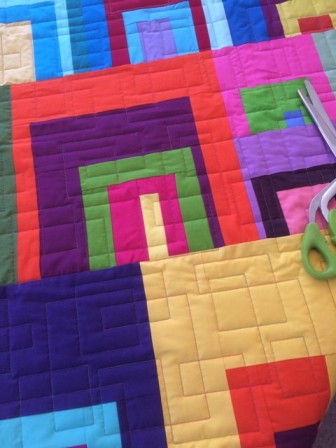 |
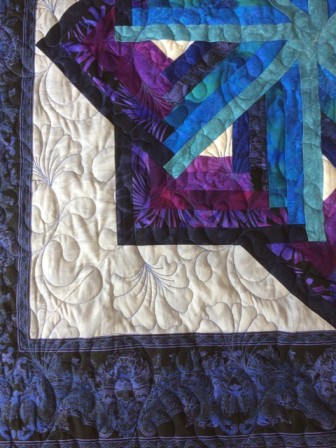 |
Design Factors for Edge-to-Edge Quilting
When choosing the right edge-to-edge for your quilt top, take design hints from your fabric. Do the fabrics in your quilt top have flowers, paisleys or baseballs? Pick an edge-to-edge design that compliments your quilt and is appropriate to the scale of your fabrics and size of your quilt blocks.
Quilt tops that are visually busy because of piecing or fabric choices are more suited to an edge-to-edge pattern. This is because the quilting will not be as visible because of the busyness of the top and custom quilting would be an unnecessary expenditure and a waste of time.
Edge-to-edge designs can also be chosen to add texture to your quilt. Using an edge-to-edge that offers both curves and movement in an organic way can enhance quilts with geometric designs. In this case, you are adding another “design element” on top of your pieced quilt pattern. Similarly quilts that contain curved piecing and/or appliqué, consider a linear quilting design such as cross-hatching for background filler. The juxtaposition of linear and organic will render a very moving visual encounter.
Even the movements of the colours in fabrics will hold clues. This is especially true of batiks. Quilts made with these fabrics are great when paired with a edge-toedge that gives the illusion of water moving over a quilt top. A flowing design is perfect.
Example of edge-to-edge quilting style
If you find that there are two or three edge-to-edge patterns that you feel would all look equally nice on the quilt top and you are not feeling drawn towards one over the other, do not agonize or over think your pattern selection. Just pick one. You will see very few quilts that will look great with only one particular pantograph. Most would be pretty with any one of a number of different approaches.
Design Factors for Custom Quilting
Generally, custom quilting is for those quilt tops that are targeted for adults or young adults sensitive to the quality and value of a well made quilt. Custom is chosen when a pieced top is made with high quality fabrics and threads, and piecing is of high calibre. Also, custom quilting is considered when a pieced top provides areas of embellishment with simple piecing, soft colours and solid or tone-on-tone fabrics where the quilting will be front and centre, so the investment can be appreciated and enjoyed.
Any quilt that contains areas of calm fabrics such as solids, tone-on-tones and gentle, soothing colours/images will allow the quilting design to stand out. Take advantage of the negative space these fabrics provide and embellish your quilt in those areas with feather wreaths, ornate feather patterns, or designs with a great deal of movement. Allow the remaining areas a simple, deliberate pattern of movement. The combination is striking and very complementary to the quilt as a whole.
Custom quilting can be a costly option and should be discussed with your chosen quilter at the time you submit your quilt. The density and complexity of the custom quilting will determine the cost.
Example of custom quilting style
Design Factors for Heirloom Quilting
Heirloom quilting can be highly decorative with a great deal of movement. It is of the highest quality quilting. It will be dense, adding its own statement to the quilt but not overriding the piecing composition. Heirloom quilting will be aesthetically pleasing and intellectually stimulating. It will leave the viewer wanting. This type of quilting, when executed with great skill, can turn the pieced top into a collector's greatest find.
A quilt in which the pattern and fabrics are deliberately and carefully chosen, that perhaps has a specific purpose and there is much more emotional investment, calls for the same deliberation and investment in a quilt design. A careful assessment of the quilt can render optimum results. This is where you can put your money, so as to marry both piecing and quilting for lovely, heirloom results
Depending on the desire, the pieced top can be quilted with remarkable results using such patterns as feathering, McTavishing, echoing and skilfully executed lovely cross-hatching and stitching in the ditch. Also the option of using different coloured threads will add another design element to the quilt.
Each design element will need to be discussed in detail between the quilt maker and long-arm quilter to ensure that both parties agree on the style elements chosen and the likely impact on the overall quit design. This consultation/design phase can be lengthy before the first stitch is even made. So Heirloom quilting takes much longer to complete as a job, meaning less of them can be done in a given time frame. Combined with the amount and quality of stitching undertaken this is why heirloom quilting is the most costly of quilting styles.
 Example of heirloom quilting style
Example of heirloom quilting style
In summary, the correct choice of a quilting style can make or break any quilt top project. So it is important that you consult with your long-arm quilter about what will be best for your quilt.
PLEASE NOTE – that due to a change in personal circumstances I am no longer able to accept Custom Quilting or Heirloom Quilting work.
For a selection of some of the most commonly used edge-to-edge quilting patterns go to the Products - Quilting Patterns page on my website
You can download and save or print the above article by clicking on this pdf icon


